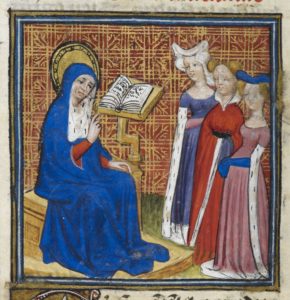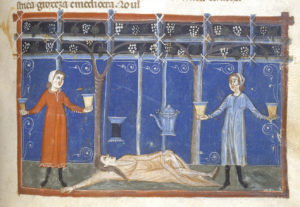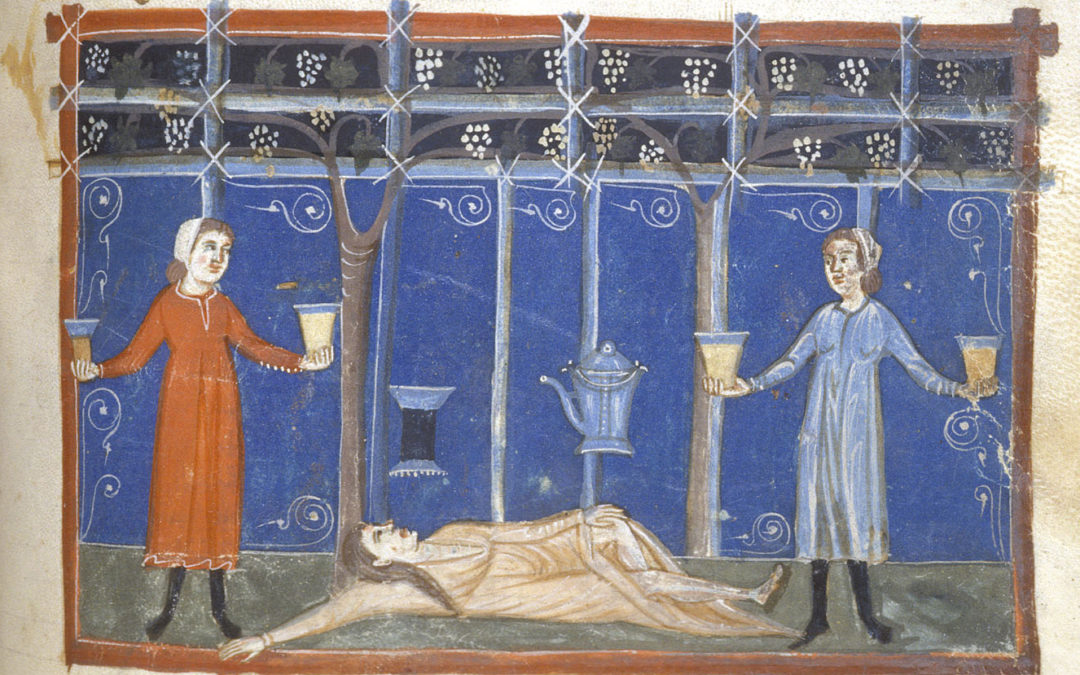This post was written by Kate Wilcox, Reader Experience and Technical Services Manager at the Institute of Historical Research Library.
The IHR library has rich collections for medieval history. The lives of medieval women are illuminated by sources across the library covering topics as varied as landholding, law, the spaces where women lived and the items they owned. A new Medieval collections guide includes some of highlights and shows how the collections are arranged.

‘Instruction of Women’ from British Library Additional 29986 f. 152v, 1407-10
Books specifically about women’s lives include edited compilations of sources and subject-specific secondary works. These can be found by searching for subjects and keywords in the catalogue. The range of themes is wide: religious women in Guidance for women in twelfth-century convents, occupations in Ale, beer and brewsters in England and legal provisions in The Welsh Law of Women. More examples, including collections of women’s wills and letters are included in the Medieval Women section of the collection guide.

‘Drunken woman’ at a vineyard from British Library Additional 8785 f. 257, before 1309
Searching the catalogue is only a start, because it will only bring up works that are primarily about women, not every mention in other works. Following up the references in monographs and periodical articles is one way to locate appropriate sources. The guides to sources held in the library may also be useful. For some subjects browsing within likely sources will be manageable and some editions have useful indexes. Online resources like British History Online allow for searching within sources. The library’s guide to free online resources includes other examples.
Many sources mention women as landholders. In the entry for Upper Clatford in Hampshire, Domesday Book mentions Adeline the jester (ioculatrix) as owner in 1086 of a small piece of land which had been given to her by an earl. A Terrier of Fleet lists the tenants of the Lincolnshire manor of Fleet in the year 1315-16, including at Fleet Hargate in the Fens, women such as Hawisia Redhede and Margareta Puddyng.
In the Selden Society’s Select cases in manorial courts, 1250-1550 an entry for 1299 describes Emma Alwine getting permission to transfer land that she held from Crowland Abbey to her daughter and son-in-law, listing what she would receive from them in return:
“William and Margaret will provide a dwelling-place for the aforesaid Emma, and they will give her yearly one quarter of wheat, one quarter of rye, one quarter of barley, half a quarter of beans and peas, and half a quarter of oats at the two terms in equal portion, namely at Michaelmas and Christmas.. And she will have one selion containing half an acre in a croft beside the land of Thomas Folkes.”
Works on architectural history can give an insight into the spaces women occupied, and catalogues of archaeological finds, e.g. Dress accessories c.1150 – c.1450, show the objects women would have owned. The prescribed clothing for different classes of people is described in ‘A Statute concerning Diet and Apparel’. ‘People of Handicraft’ and Yeomen are not allowed to wear clothing above a certain value:
“nor Stone, nor Cloth of Silk nor of Silver, nor Girdle, Knife, Button, Ring, Garter, nor Owche, Ribband, Chains nor no such other Things of Gold nor of Silver, nor no Manner of Apparel embroidered, aimeled, nor of Silk by no Way; and that their Wives, Daughters, and Children, be of the same Condition in their Vesture and Apparel ; and that they wear no Veil of Silk, but only of Yarn made within the Realm, nor no Manner of Furr, nor of Budge, but only Lamb, Cony, Cat, and Fox.” (Statutes of the Realm , 37 Edward III c.9).
Three new guides to the IHR library show some highlights by period: medieval history, early modern history and modern history and researchers can find much more across the library’s collections.

